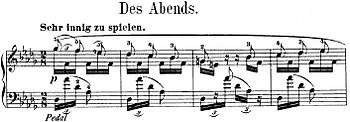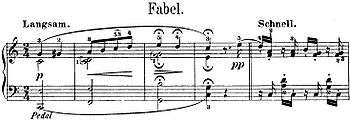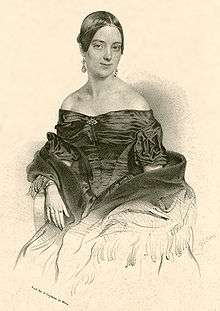Fantasiestücke, Op. 12
Robert Schumann's Fantasiestücke, Op. 12, is a set of eight pieces for piano, written in 1837. The title was inspired by the 1814 collection of novellas Fantasiestücke in Callots Manier by one of his favourite authors, E. T. A. Hoffmann. Schumann dedicated the pieces to Fräulein Anna Robena Laidlaw, an accomplished and attractive 18-year-old Scottish pianist with whom Schumann had become good friends.[1]
Schumann composed the pieces with the characters Florestan and Eusebius in mind, representing the duality of his personality. Eusebius depicts the dreamer in Schumann while Florestan represents his passionate side. These two characters parlay with one another throughout the collection, ending self-reflectively with Eusebius in "Ende vom Lied".
Details

1. "Des Abends" ("In the Evening") in D-flat major / Sehr innig zu spielen (Play very intimately)
 |
Schumann, after completing the work, then gave the piece its title, which introduces the character of Eusebius, who serves as a symbolic representation of Schumann's dreamy self. He intended the imagery to be a "gentle picture of dusk."[2] |
2. "Aufschwung" ("Soaring", literally "Upswing") in F minor / Sehr rasch (Very rapidly)
 |
Schumann conceived of "Aufschwung" as a depiction of the character Florestan (from Beethoven's Fidelio) indulging in his desires, and as the Norton Anthology of Western Music describes "at the height of his passions."[3] |
3. "Warum?" ("Why?") in D-flat major / Langsam und zart (Slowly and tenderly)
 |
The title "Why?" was intended by Schumann to signify Eusebius's reflection on the excesses of Florestan in "Aufschwung".[3] The piece proceeds with "gentle questioning" and ends with an "inconclusive answer."[2] |
4. "Grillen" ("Whims") in D-flat major / Mit Humor (With humor)
 |
With its whimsical, quirky nature, this piece solely represents Florestan and his eccentricities.[2] |
5. "In der Nacht" ("In the Night") in F minor / Mit Leidenschaft (With passion)
 |
The two characters of Florestan and Eusebius (the interaction of which Schumann was attempting to represent within the Fantasiestücke) unite for the first time in this piece, which has both "passion together with nocturnal calm."[2] Schumann is said to have perceived in "In der Nacht" the story of Hero and Leander, albeit not until after writing it. |
6. "Fabel" ("Fable") in C major / Langsam (Slowly)
 |
Like the previous piece, this also juxtaposes both the passionate and dreamy side of Schumann within the same work (as opposed to representing each separately, as in the first subset). The key of C major breaks from the pattern of D-flat major/F minor established by the previous pieces. In this piece, the whimsical nature of Florestan is set against the ethereal tranquility of Eusebius, resulting in a "placid narrative together with rich veins of humor."[2] |
7. "Traumes Wirren" ("Dream's Confusions") in F major / Äußerst lebhaft (Extremely lively)
 |
The title is implicative of the struggle between the dreams and the passions within Schumann. In this piece the dreamy quality of Schumann, represented by the character of Eusebius, becomes entangled by the passions of Florestan, who symbolizes Schumann's more emotional side. Like the previous piece, this piece also departs from the established D-flat major/F minor key signature scheme, as it is written in the key of F major which is also the key of "Ende vom Lied", the next piece. The piece is rhythmically intense and a rapid pulse permeates it.[2] |
8. "Ende vom Lied" ("End of the Song") in F major / Mit gutem Humor (With good humor)
 |
Schumann described this piece as a combination of wedding bells and funeral bells. In a letter to Clara Schumann, his wife, he wrote about this last piece: "At the time, I thought: well in the end it all resolves itself into a jolly wedding. But at the close, my painful anxiety about you returned."[2] |
References
- ↑ J. C. Hadden, ‘Laidlaw , Anna Robena Keddy (1819–1901)’, rev. Anne Pimlott Baker, Oxford Dictionary of National Biography, Oxford University Press, 2004; online edn, May 2008 accessed 28 Jan 2015
- 1 2 3 4 5 6 7 Ewen, David, The Complete Book of Classical Music, p. 474, Prentice Hall, 1965
- 1 2 J. Peter Burkholder, Claude V. Palisca, Norton Anthology of Western Music, Vol. 2: Classic to Twentieth century, Fifth edition, Norton, New York London, 2006
External links
- Fantasiestücke, Op. 12 (Schumann, Robert): Scores at the International Music Score Library Project
- Free score at kostenlose-klaviernoten.de
- Notes at Naxos Records
- "Fabel" and "Traumeswirren" from Fantasiestücke played by Arthur Rubinstein at Internet Archive (Open Source Movies)
